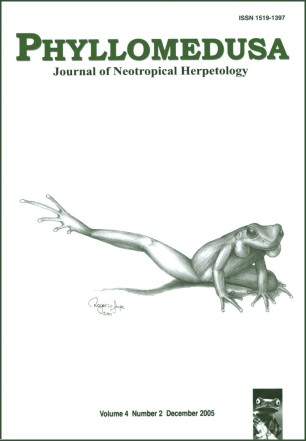Visual communication, reproductive behavior, and home range of Hylodes dactylocinus (Anura, Leptodactylidae)
DOI:
https://doi.org/10.11606/issn.2316-9079.v4i2p147-158Keywords:
Anura, Leptodactylidae, Hylodinae, Hylodes dactylocinus, home range, reproductive behavior, visual communication, Atlantic Forest, southeastern BrazilAbstract
We studied the signaling, reproductive and courtship behaviors of the diurnal stream-dwelling frog Hylodes dactylocinus. The repertoire of visual signals of H. dactylocinus includes foot-flagging, leg-stretching, body movements, and toe-wiggling. The visual signals are performed only by males and are used to defend territories against intruders and to attract females. Home range size varied from 0.12 to 13.12 m² for males (N = 44), and from 0.45 to 7.98 m² for females (N = 24); residency time varied from one to 12 months for males, and from two to 10 months for females. During the courtship of H. dactylocinus the male gives an encounter call towards an approaching female, touches her snout, and guides her to a previously dug nest. After oviposition, the female leaves the nest and returns to her own home range; the male remains calling after concealing the nest entrance.Downloads
Download data is not yet available.
Downloads
Published
2005-12-01
Issue
Section
Articles
License
All material originally published in Phyllomedusa belongs to Escola Superior de Agricultura Luiz de Queiroz - Universidade de São Paulo. All contents are under a license of Creative Commons BY-NC-ND.How to Cite
Narvaes, P., & Rodrigues, M. T. (2005). Visual communication, reproductive behavior, and home range of Hylodes dactylocinus (Anura, Leptodactylidae). Phyllomedusa: Journal of Herpetology, 4(2), 147-158. https://doi.org/10.11606/issn.2316-9079.v4i2p147-158



 Impact Factor (JCR): 0.600
Impact Factor (JCR): 0.600 CiteScore: 1.0
CiteScore: 1.0